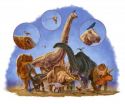(Press-News.org) Although most dinosaurs went extinct 65 million years ago, one dinosaur lineage survived and lives on today as a major evolutionary success story – the birds. But to what does this lineage owe its success? A study that has 'weighed' hundreds of dinosaurs now suggests that shrinking their bodies may have helped this group to continue exploiting new ecological niches throughout their evolution, and to become such a diverse and widespread group of animals today.
An international team, led by scientists from Oxford University and the Royal Ontario Museum, estimated the body mass of 426 dinosaur species based on the thickness of their leg bones. The team found that dinosaurs showed rapid changes in body size shortly after their origins, around 220 million years ago. However, these soon slowed: only the evolutionary line leading to birds continued to change size at this rate, and did so for a further 170 million years, producing new ecological diversity not seen in other dinosaur lineages.
A report of the research is being published May 6 in the open access journal PLOS Biology.
'Dinosaurs aren't extinct; there are about 10,000 species alive today in the form of birds. We wanted to understand the evolutionary links between this exceptional living group, and their Mesozoic relatives, including well-known extinct species like T. rex, Triceratops, and Stegosaurus,' said Dr Roger Benson of Oxford University's Department of Earth Sciences, who led the study. 'We found exceptional body mass variation in the dinosaur line leading to birds, especially in the feathered dinosaurs called maniraptorans. These include Jurassic Park's Velociraptor, birds, and a huge range of other forms, weighing anything from 15 grams to 3 tonnes, and eating meat, plants, and more omnivorous diets.'
The team believes that small body size might have been key to maintaining evolutionary potential in birds, which broke the lower body size limit of around 1 kilogram seen in other dinosaurs.
'How do you weigh a dinosaur? You can do it by measuring the thickness of its leg bones, like the femur. This is quite reliable,' said Dr Nicolás Campione, of the Uppsala University, another member of the team. 'This shows that the biggest dinosaur Argentinosaurus, at 90 tonnes, was 6 million times the weight of the smallest Mesozoic dinosaur, a sparrow-sized bird called Qiliania, weighing 15 grams. Clearly, the dinosaur body plan was extremely versatile.'
The team examined rates of body size evolution on the entire family tree of dinosaurs, sampled throughout their first 160 million years on Earth. If close relatives are fairly similar in size, then evolution was probably quite slow; conversely, if they're very different in size, then this implies that evolution was fast.
'What we found was striking. Dinosaur body size evolved very rapidly in early forms, likely associated with the invasion of new ecological niches. In general, rates slowed down as these lineages continued to diversify,' said Dr David Evans at the Royal Ontario Museum, who co-devised the project. 'But it's the sustained high rates of evolution in the feathered maniraptoran dinosaur lineage that led to birds – the second great evolutionary radiation of dinosaurs.'
The evolutionary line leading to birds kept experimenting with different, often radically smaller, body sizes – enabling new body 'designs' and adaptations to arise more rapidly than among larger dinosaurs. Other dinosaur groups failed to do this, got locked in to narrow ecological niches, and ultimately went extinct. This suggests that important living groups such as birds might result from sustained, rapid evolutionary rates over timescales of hundreds of millions of years, which could not be observed without fossils.
Drs Daniel Moen and Hélène Morlon of the Ecole Normale Supérieure in Paris, who are not connected with the study, wrote in an accompanying Primer in PLOS Biology "What explains why some groups of organisms, like birds, are so species rich? And what explains their extraordinary ecological diversity, ranging from large, flightless birds, to small migratory species that fly thousands of kilometers every year? [Benson and colleagues] find that body-size evolution did not slow down in the lineage leading to birds, hinting at why birds survived to the present day and diversified. This paper represents one of the most convincing attempts at understanding deep time adaptive radiations."
INFORMATION:
Please mention PLOS Biology as the source for this article and include the links below in your coverage to take readers to the online, open access articles
All works published in PLOS Biology are open access, which means that everything is immediately and freely available. Use this URL in your coverage to provide readers access to the paper upon publication:
http://www.plosbiology.org/article/info:doi/10.1371/journal.pbio.1001853
Contact:
Dr Roger Benson
Oxford University
+44 (0)1865 272076 or email rogerb@earth.ox.ac.uk
Oxford University News Office
+44 (0)1865 283877 or email news.office@admin.ox.ac.uk
Citation: Benson RBJ, Campione NE, Carrano MT, Mannion PD, Sullivan C, et al. (2014) Rates of Dinosaur Body Mass Evolution Indicate 170 Million Years of Sustained Ecological Innovation on the Avian Stem Lineage. PLoS Biol 12(5): e1001853. doi:10.1371/journal.pbio.1001853
Funding: Parts of this project were supported by a Leverhulme Research Grant (to Paul Upchurch) RPG-129. PDM is funded by an Imperial College Junior Research Fellowship. The funders had no role in study design, data collection and analysis, decision to publish, or preparation of the manuscript.
Competing Interests: The authors have declared that no competing interests exist
Dinosaurs and birds kept evolving by shrinking
2014-05-07
ELSE PRESS RELEASES FROM THIS DATE:
Shrinking helped dinosaurs and birds to keep evolving
2014-05-07
A study that has 'weighed' hundreds of dinosaurs suggests that shrinking their bodies may have helped the group that became birds to continue exploiting new ecological niches throughout their evolution, and become hugely successful today.
An international team, led by scientists at Oxford University and the Royal Ontario Museum, estimated the body mass of 426 dinosaur species based on the thickness of their leg bones. The team found that dinosaurs showed rapid rates of body size evolution shortly after their origins, around 220 million years ago. However, these soon slowed: ...
Patients with AMD may not need monthly injections
2014-05-07
Orlando, Fla. — Researchers have found that, contrary to prvious clinical trial findings, monthly injections to counteract age-related macular degeneration (AMD) may not be necessary. The research is being presented at the 2014 Annual Meeting of the Association for Research in Vision and Ophthalmology (ARVO) this week in Orlando, Fla.
The investigators used a strategy called "treat and extend" to conduct the study, in which the frequency of office visits and injections were tailored to each patient's individual response to therapy. Following 185 patients over a three-and-a-half-year ...
AGU journal highlights -- May 6, 2014
2014-05-06
The following highlights summarize research papers that have been recently published in Geophysical Research Letters (GRL), Journal of Geophysical Research: Earth Surface (JGR-F), Journal of Geophysical Research: Oceans (JGR-C), and Water Resources Research (WRR).
In this release:
1. Polar hexagon-shaped jet stream could reveal Saturn's rotational period
2. Antarctica's Whillans Ice Plain ice flows are highly variable
3. Climate change, water rights, and agriculture: A case study in Idaho
4. Low impact development boosts groundwater recharge
5. Beaufort Gyre sea ...
Black male incarceration can compromise research studies
2014-05-06
Federal restrictions on including prisoners in medical research have negatively impacted research involving black men, who are disproportionately imprisoned, according to a study by Yale School of Medicine researchers. Because individuals who are already in ongoing studies must be dropped if they are incarcerated, this compromises the ability of researchers to examine racial disparities in health outcomes studies.
Published in the May issue of the journal Health Affairs, the study found that during the past three decades, high rates of incarceration of black men may ...
When newlyweds believe in sharing household chores, follow-through is everything
2014-05-06
URBANA, Ill. – Of all the starry-eyed just-married couples you know, which couples are likely to stay the happiest? A University of Illinois study says chances for bliss are highest when husband and wife both believe in divvying up the household labor equally. But that happiness won't last long if one partner is perceived as not carrying their fair share of the load.
"Newlyweds need to thoughtfully plan how they can make their expectations about sharing chores work out in real life, especially if the new spouses strongly value gender equality in household labor. This ...
New 'magnifying glass' helps spot delinquency risks
2014-05-06
PULLMAN, Wash. - Drug abuse, acts of rampage – what's really the matter with kids today? While there are many places to lay blame – family, attitude, peers, school, community – a new study shows that those risks vary in intensity from kid to kid and can be identified.
Scientists at Washington State University and Pennsylvania State University have found a way to spot the adolescents most susceptible to specific risk factors for delinquency. Breaking down a survey of over 30,000 teens, researchers were able to pinpoint five subgroups and the risks for delinquency that ...
'Exploding head syndrome' -- a real but overlooked sleep disorder
2014-05-06
PULLMAN, Wash.—It sounds like a phrase from Urban Dictionary, or the title of an animated gif, but a Washington State University researcher says "exploding head syndrome" is an authentic and largely overlooked phenomenon that warrants a deeper look.
"It's a provocative and understudied phenomenon," said Brian Sharpless, a WSU assistant professor and director of the university psychology clinic, who recently reviewed the scientific literature on the disorder for the journal Sleep Medicine Reviews. "I've worked with some individuals who have it seven times a night, so it ...
New Mayo Clinic cardiovascular surgical care model improves care value, predictability and the patient experience
2014-05-06
ROCHESTER, Minn. — New research from Mayo Clinic shows that implementing a uniform method to care for lower-risk cardiac surgical patients improves outcomes, reduces patients' time in the hospital and lowers overall per patient costs by 15 percent. The study is published in the May issue of Health Affairs.
MULTIMEDIA ALERT: Video and audio are available for download on the Mayo Clinic News Network.
"In the high-acuity, full-service hospital, individual clinical judgment remains key, and some medical care demands this," says David Cook, M.D., a Mayo Clinic anesthesiologist ...
College kids need to change unhealthy ways
2014-05-06
CHICAGO --- Parents, forget the comfort food! It's time to send your college students care packages of fruit, veggies and exercise gear instead.
A new study from Northwestern Medicine® and Northeastern Illinois University found that the majority of college students are engaging in unhealthy behaviors that could increase their risk of cancer later on. Racial minority students could be at an even greater risk, especially African Americans and Native Americans.
A shocking 95 percent of college students fail to eat the recommended amount of fruit and vegetables (five or ...
NeuroStar TMS therapy shows favorable outcomes compared to antidepressants for depression
2014-05-06
NEW YORK, May 6, 2014 – Neuronetics, Inc. announced today a new analysis of data at the annual meeting of the American Psychiatric Association that shows Transcranial Magnetic Stimulation (TMS) administered with the NeuroStar TMS Therapy System resulted in greater symptom improvement than next-choice conventional antidepressant medication among patients with Major Depressive Disorder (MDD) who failed to benefit from prior antidepressant medication. In a propensity-score matched analysis of data from two independent studies, patient-reported symptom outcomes measured by ...


